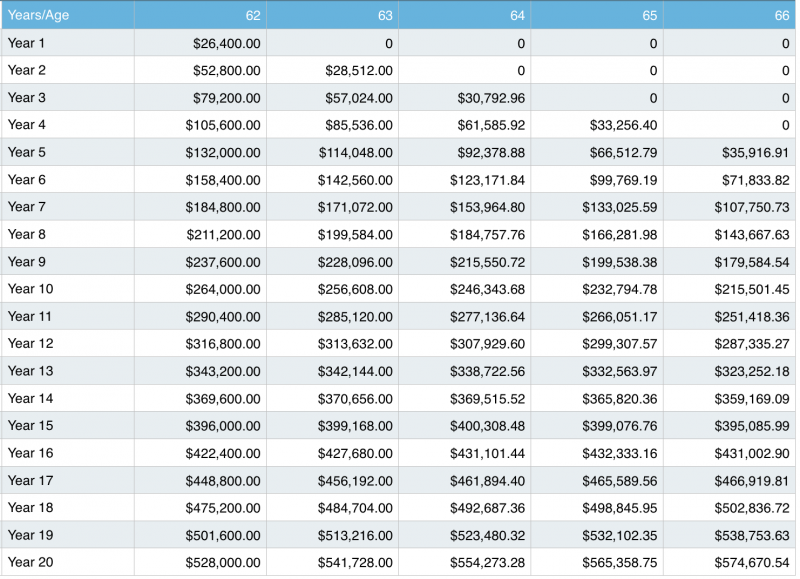
Private Pensions offer the holder a multitude of options, in extreme cases I have reviewed plans with over a dozen different choices for the account holder. Here’s some key criteria that you should consider when reviewing your options:
Make sure you are vested
Before we look at the options, it is important to ensure you are vested in the pension, and to look at its inner workings in order to make smart decisions on when is the best time to sever the contract. Pension or retirement annuity plans offered by an employer typically take time to vest. This period is designed to encourage employees to stick around, and make the incentive work for both the Employer or Employee. Vesting periods differ depending on the plan documents, though it is quite common to find yourself with a 5 year cliff.
The Cliff concept means that once you reach the 5 year mark you are vested in full. But that still means that you are subject to the earning rules of the plan, this is usually a calculation based on average salary and years of service. Here’s some examples:
Employee A,B,C all earn the following salary, with a 5 year cliff, the Pension plan considers the last 4 years of earnings:
- $40,000 Year 1
- $42,000 Year 2
- $45,000 Year 3
- $48,000 Year 4
- $60,000 Year 5
- $64,000 Year 6
- $66,000 Year 7
Employee B quits after year 5. The pension plan rules state that the last 4 years of earnings are considered in calculating the benefit:
- [$60,000+$48,0000+$45,000+$42,000] ÷ 4 = $48,750
Employee C quits after year 7:
- [$66,000+$64,000+$60,000+$48,000] ÷ 4 = $59,500
Turning the number into something ‘meaningful’
It is incorrect to think of the two numbers above ($243,750 and $416,500) as part of your pension fund. Their purpose in the illustration is to simply highlight that both the average amount and the years of service matter. This varies by plan, so read the documents. However, these amounts would influence the amount that you receive, after being factored down by your pension plan rules.
For example, depending on the plan, Employee B from above might have earned a full retirement age pension in the region of $410 per month. If we consider that in relation to the number of $243,750 we can see a divisor of 0.00168. Applying that to Employee C might provide for a monthly retirement pension value of around $700.
The above illustration is to show the impact of waiting for vesting, and also how rules, whether it be 4 year average or others, can adjust the amount of your payment. Some plans use the single highest year of earning, and you’ll see people manipulate this by adding in excessive overtime, this is known as pension spiking.
As you can see, if you are subjected to a Cliff policy it is critical to understand when you vest, and it is also necessary to price in the value of a competitive salary offer with what would be lost by foregoing the cliff, or the impact of salary averaging.
You’re vested, and you’ve left – what now?
This is when you have to really look at your options. While you may have dozens, the core of these will be to consider accepting a lump sum amount vs annuitizing the payments of the pension over the future months. Some common examples:
Lump Sum
One off payment from the pension company. Can be rolled into IRA. EG $138,000
Life Annuity (single life)
Highest monthly amount, payments cease upon death of policy holder. EG $1200 per month
Joint and Survivor (50%)
The beneficiary gets a payment after the policy holders death. EG $1000 Primary, $500 for survivor per month.
Joint and Survivor (100%)
The beneficiary gets the same as the primary. EG $800,800 per month.
Period Certain
Various amounts of time, such as 10 years ‘certain’ meaning that if the policy holder were to die on year 6 the beneficiary would receive payments for the next 4 years, 10 years are certain. EG $1150
There are many more options, some combine parts of the above, such as 50% lump sum with single/joint annuity.
More data required.
The key to this decision requires more data than you have at this point. That key is simply: what is the inherent value of each option? Knowing this tells you the best option (mathematically at least) to elect. But the issue is complicated a little by ‘assumptions’ that are baked into your policy, such as rate of return, cost of living adjustments, and so forth.
Request plan projections for at least two time frames
When you first terminate service you will receive a packet that contains the offers (or variations on them) for a few different scenarios. That might be: today vs age 62 (or when your plan is considered full retirement) but what happens if you wanted to defer longer, perhaps until age 66? What is the growth rate that you are being offered? This is the key to knowing what you are ‘giving up’ when you take your election.
It’s not just compound interest… it is missed payments too.
If we looked at the lump sum option above, $138,000 for age 62. If the offer to defer until 66 is $140K its clearly a bad deal… but what would be a good deal? For a lump sum, it is pure compound interest. But when you pick your desired rate of return it is critical to factor in an investment of equivalent risk. If the offer to defer exceeds what you could earn for the same risk elsewhere, it is a deal.
When you take the annuity approach though, the period that you defer also includes time where you aren’t receiving income, so it has double impact. This doesn’t mean it is wrong to defer into a greater monthly payment, but it must be remembered that you need to beat the game (live that much longer than they hope to pay you) in order to really maximise that.
The 8% Example
With today’s rate of interest, if you were offered an 8% growth on your pension per year from age 62-66, you might be inclined to take it. Note that 8% is the same rate of growth on social security deferral. Let’s look at an offer for delaying for a $250,000 lump sum/$2,200 monthly payments on a single life annuity.

Value of delaying for certain growth
As you can see from the table above, even taking a guaranteed 8% return would require waiting until:
- Year 14 for 1 year of missed payments to be caught up
- Year 15 for the other deferral options to be superior to taking the money at age 62.
The above table shows how 8% growth would increase the monthly (annualized in the example) payments, but if one were to defer receiving payments then it is possible that this might force them to liquidate other assets in order to deal with consumption demand. If you were to consider the annual inflow of $26,400 removed the need to liquidate that amount earning 3%, there might be another $5,000 in lost opportunity.
Conclusion
Pensions are complicated, but as a general rule of thumb the pension company would like to buy you out of your contract earlier in order to reduce risk. That said, the lump sum (the buy out) offer is often not an attractive amount as there are many people who will either due to need, or poor judgement, take the lump sum amount. When you leave a company with a vested pension ask them to run a projection number for you with a few dates, such as full retirement age and deferred retirement age, as you can see if you’ve inadvertently joined a plan which offers favorable terms or not.
Lastly, remember that there is value in having diverse income streams in retirement. Having a guaranteed income flow, even if they do not cover 100% needs for your life is very valuable. If you have pension questions, feel free to ask them in comments, or send me a message privately and I’ll be glad to help.
The post Private Pensions – know your options appeared first on Saverocity Finance.
Continue reading...
